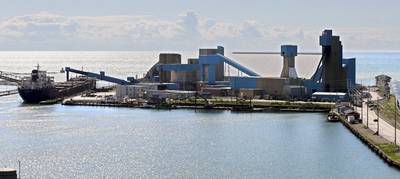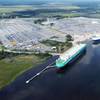St. Lawrence Seaway Cargo Up 5% Over 2013
Total cargo shipments on the St. Lawrence Seaway have now surpassed 2013 levels by 5 percent due to strong North American import/export activity.
According to the St. Lawrence Seaway, total cargo tonnage from March 25 to September 30 reached 24.4 million metric tons.
Stephen Brooks, President of the Chamber of Marine Commerce, said, “September was another strong month for the St. Lawrence Seaway as marine shipping helped U.S. companies export products and import much-needed materials. Many people don’t realize that ships are regularly carrying a huge amount of trade between Canada and the U.S. via the Great Lakes-Seaway. For many companies, it is also the most cost-effective and direct route to import and export goods to and from European markets.”
Grain exports continue to be strong with total shipments (including Canada and the U.S.) reaching 6.8 million metric tons, up 70 percent over the same period last year. U.S. grain totaled 796,000 metric tons, up 15 percent over the same period last year.
Joe Cappel, Director of Cargo Development for the Toledo-Lucas County Port Authority, said, "Grain shipments from Toledo to Ontario and Quebec have been strong in August and September due to demand for corn for ethanol production and animal feed. Imports of steel from Canada and Italy have also been a steady contributor to our increases in general cargo shipments."
Corn shipments from Port of Toledo to Ontario and Quebec for ethanol production and animal feed, for example, increased significantly over the past two months.
The Seaway’s general cargo tonnage — including specialty steel imports as well as aluminum and oversized project cargo like machinery or wind turbines — as of September 30 had topped 1.9 million metric tons, up 73 percent. Specialty steel imports accounted for 1.7 million metric tons of that overall number.
Steel has been a hot commodity throughout the Great Lakes region, with shipments from overseas heading to ports in Toledo, Cleveland, Detroit, Burns Harbor, Milwaukee, Oshawa and Hamilton to be used in domestic automobile production and construction.
The Port of Green Bay has also seen a 50 percent increase in foreign exports of petroleum products such as ethanol, diesel and gasoline for the period up to August 30. The products have been travelling to Sarnia, Ontario and the Montreal, Quebec region.
Dean Haen, Director, Brown County Port and Resource Recovery Department, said, "Cargo shipments through the Port of Green Bay are up 10 percent this season to date and that's factoring in a loss of six weeks of shipping season as we were one of the last ports to be ice-free. It's a reflection of our robust economy. We're seeing substantial volumes of limestone and petroleum coke coming into the port and petroleum products like ethanol, diesel and gasoline heading out for foreign export."
Municipal stockpiling of road salt ahead of the coming winter has also driven shipments via the Seaway up by 32 percent this season to 1.9 million metric tons.
These areas of strength have helped to offset decreases in shipments of other commodities through the navigation system.











